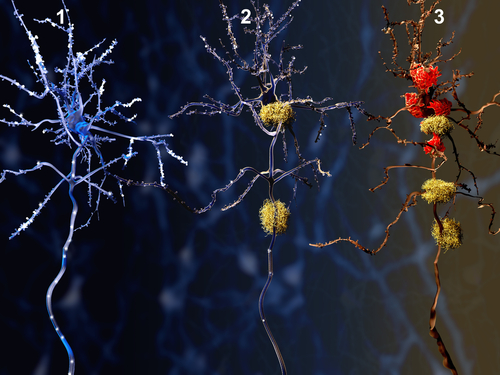Inhibiting USP13 Enzyme Can Help Destroy Toxic Alpha-Synuclein Clumps, Mouse Study Finds

Inhibiting an enzyme called USP13 may represent an attractive therapeutic target for Parkinson’s and other neurodegenerative diseases, preclinical data suggests.
These findings also could hold important implications for a therapy currently being developed to treat Parkinson’s disease — nilotinib.
The study, “Ubiquitin specific protease-13 independently regulates parkin ubiquitination and alpha-synuclein clearance in alpha-synucleinopathies,” was published in Human Molecular Genetics.
USP13 belongs to a large family of enzymes called de-ubiquitinases known for their ability to cut chains of a small protein known as ubiquitin that is present inside stress-induced clumps of proteins and other molecules.
Ubiquitination is like a cellular tagging system: By adding an ubiquitin molecule to a protein, it marks it for degradation.
Previous research has shown that USP13 and another similar enzyme called USP5 are important in helping to dismantle clumps of molecules that form when cells are stressed by external factors, called “stress granules.”
Want to learn more about the latest research in Parkinson’s Disease? Ask your questions in our research forum.
Now Georgetown University Medical Center researchers have found that one reason clumps of alpha-synuclein, known as Lewy bodies, develop and accumulate in the brain is that USP13 removes all the “tags” placed on alpha-synuclein that mark it for destruction, or ubiquitination. Toxic aggregates of alpha-synuclein accumulate and are not efficiently cleared.
Researchers analyzed brain tissue samples collected postmortem from 11 patients with Parkinson’s disease. USP13 levels were about 3.5 times higher than samples from subjects not affected by Parkinson’s.
To better understand the role of USP13, researchers used a genetic approach to either increase or decrease the levels of USP13 in mouse neurons cultured in a laboratory dish. These neurons expressed high levels of alpha-synuclein.
The presence of alpha-synuclein alone significantly increased the levels of parkin ubiquitination. Parkin is a protein often found mutated in some Parkinson’s patients.
The team had previously shown that an increase in parkin ubiquitination led to clearance of neurotoxic proteins, including alpha-synuclein, in several animal models of neurodegeneration.
However, expression of high levels of USP13 and alpha-synuclein together significantly reduced parkin ubiquitination, suggesting that USP13 can modulate parkin response.
“Taken together, these data suggest that USP13 may regulate parkin ubiquitination/de-ubiquination cycle,” the researchers wrote.
Additional experiments revealed that decreasing the levels of USP13 increased alpha-synuclein ubiquitination and destruction.
Knocking out the USP13 gene in a mouse model of Parkinson’s disease was able to prevent alpha-synuclein-induced death of dopamine-producing brain cells. Also, genetic inhibition of USP13 led to significant improvement in animals’ motor performance, while improving the clearance of alpa-synuclein toxic molecules.
Importantly, researchers found that a new therapy being studied to treat Parkinson’s disease, nilotinib, worked better when USP13 was inhibited.
Results from a recent Phase 2 clinical trial (NCT02954978) conducted by Novartis showed that nilotinib can modulate dopamine levels and metabolism, as well as prevent the formation of toxic alpha-synuclein aggregates.
Nilotinib is available under the brand name Tasigna as an approved treatment for certain types of leukemia.
“Our discovery clearly indicates that inhibition of USP13 is a strategic step to activate parkin … to increase toxic protein clearance,” Charbel Moussa, PhD, director of Georgetown University Medical Center Translational Neurotherapeutics Program and senior author of the study, said in a press release. “Our next step is to develop a small molecule inhibitor of USP13 to be used in combination with nilotinib in order to maximize protein clearance in Parkinson’s and other neurodegenerative diseases.”






